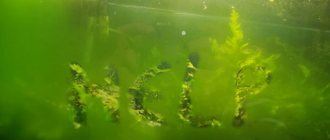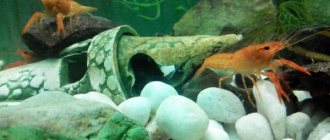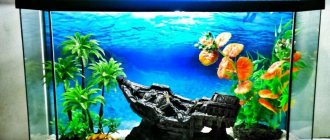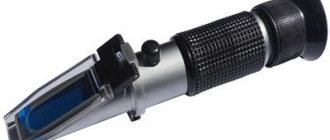Quickly navigate to the article
- 1 Why clean an aquarium
- 2 Types of siphons for an aquarium
- 3 How to siphon soil in an aquarium correctly
- 4 Benefits and harms of siphon soil cleaning
- 5 When not to siphon
- 6 What can you do to siphon less often 6.1 Other interesting articles
In every aquarium, even the most frequently and efficiently cleaned, organic waste appears. These elements settle on the ground and accumulate in it. In order to maintain cleanliness inside the reservoir, it is necessary to siphon the soil in the aquarium. Beginning aquarists should know how to carry out this procedure correctly and with what means.
Why clean your aquarium?
Regular care is required for every aquarium, regardless of its size and number of inhabitants. At the bottom of the aquarium there is soil (substrate), it can be either sand with large particles, or pebbles, lava, or coral chips. The main role of soil in an aquarium is the habitat of bacteria involved in the biobalance of the reservoir. In the process of life, the substrate accumulates food residues and excrement of the inhabitants, parts of dead plants, leaves and stems, all these elements settle to the bottom.
Organic waste particles should be present in the aquarium, they work to form an ideally sustainable and natural process. Gradually, the level of accumulated organic matter increases; it can exceed the norm for polluting water. Such soil must be siphoned. Cleaning the aquarium is important to ensure the quality of life of the inhabitants and plants.
Contamination can occur if there is a mismatch in the number of fish and plants within one body of water, for example, with a small amount of flora and a large number of inhabitants, the volume of fish excrement and food residues increases, which leads to the need to clean the aquarium. Before siphoning the soil, it is important to familiarize yourself with the types of siphons and choose the right one.
Siphonka
Cleaning the aquarium using a siphon is an ideal option. But it is not suitable if you have a lot of small fish and plants. If the fish are large and there is little vegetation, then you can start cleaning. Cleaning the soil using a siphon looks like this:
- We prepare the siphon.
- We stick the funnel cylinder into the ground and stir it, without staying in one place for more than 5 seconds.
- We direct the end of the hose into the substituted container. Water and all debris from the bottom will drain through the hose.
- When clean water flows through the hose, the cleaning process can be completed.
- Now you will need to add the settled water to the aquarium instead of the drained water.
For several hours after cleaning the aquarium with a siphon, the water will be cloudy. There is no need to worry about this. It will settle and become transparent.
Types of siphons for an aquarium
Siphons differ in types depending on their characteristics:
- size;
- method of absorption;
- funnel section shapes.
Regarding the size, cleaning devices can be standard, designed for large aquariums and small for nano aquariums. Depending on the cross-sectional shape of the funnel, the siphon can be:
- rounded siphon with one right angle;
- narrow.
The first version of the siphon is universal and convenient; the right angle is designed for cleaning corners. With this device you can clean the entire area of the container. A specialized narrow siphon tube is designed for cleaning in crevices between objects, plants and other hard-to-reach places.
There are electrical devices that run on batteries. The device can operate in two ways:
- The first is that water is sucked into the sewer or another special bowl.
- The second method involves returning the water passed through the filters back into the aquarium.
This simple device is especially necessary when large water changes are not recommended. The electric device is used for containers with a water level of no more than 50 cm.
The simplest and most affordable version of a siphon that you can make yourself is a plastic flask with a soft hose or a wide plastic funnel attachment, a hose and a rubber bulb. In the first option, water will be pumped through a hose to help the liquid move, it is necessary to draw air from the tube. To avoid contact with soil elements, the hose is pressed by hand so that the granules fall to their original place. Using a funnel attached to a hose, a mud cleaner works on the following principle: the funnel is lowered to the surface, the other end of the hose is in a bowl for receiving water. The bowl should be located strictly below the artificial reservoir (then, according to the laws of physics, the water will flow without constant “pumping”).
The water pressure depends on the width of the siphon tube. The wider the tube, the more powerful the pressure. The hose should be transparent to make it easier to monitor the cleaning process while moving the siphon inside the aquarium.
Necessary equipment
It is impossible to properly clean an aquarium without the use of special equipment. To clean the soil you will need aquarium cleaners: a siphon or a special aquarium vacuum cleaner. The choice of cleaner depends on how often the aquarium needs to be cleaned.
To clean the glass from plaque you will need a scraper. The simplest version of this tool is a plastic handle with a metal blade attached to the end. Magnetic scrapers can also be found in pet stores. They are used to clean tanks made of plexiglass and acrylic, because... they do not leave scratches on the material.
Other equipment that may be needed during the cleaning process:
- net;
- bucket or other deep container;
- sponge;
- brush;
- brush;
- rag;
- paper towels.
How to siphon soil in an aquarium correctly
Siphoning the soil, as a rule, should occur along with changing the aquarium water. It is not recommended to push the siphon hose very deep into the substrate; it is enough to clean the top layer.
Particular care should be taken to clean areas in corners, under various elements and snags. It is forbidden to siphon layers of soil near plants with a strong root system, since all organic sediments are an excellent food source for them, necessary for successful life.
The cleaning interval and quantity depend on the specific aquarium. Whether it is necessary to siphon soil with plants and fish depends on the number of inhabitants, the type of fish, the frequency of feeding and the type of soil in the aquarium. In a large reservoir with large fish without plants, cleaning should be carried out regularly once every 2 weeks. If the container is densely populated, the frequency of cleaning is reduced to 1 week. They also siphon the nurseries where the young fish live every day, despite the fact that there is no soil there.
Particular care should be taken when cleaning a tank that is planted with plants that have roots. It is not recommended to deepen the siphon in the landing zone. This procedure should be carried out no more than once a year.
Signs that a surface needs to be siphoned:
- if you disturb the soil with a stick, air bubbles and turbidity are released from it;
- the roots of the plants have turned brown and are rotting; this can be detected during weeding.
We settle in assistants
To clean less often, you can place natural orderlies in the aquarium, who help clean the water and walls of your home pond. This will be done, for example, by ordinary guppies, as well as swordtails, goldfish, platies, ancistrus, and catfish. The structure of their mouth allows them to capture and eat small algae and plaque from the walls.
But not only these fish clean their homes. Snails and shrimp can help them. True, snails are very curious creatures, and if the aquarium is open at the top, they will periodically fall out of it (so it is better to purchase such residents for closed containers).
So, to keep your aquatic pets alert and healthy, it is important to properly care for your aquarium. If you use live assistants, you will have to clean the tank and disturb the aquarium animals less often.
The benefits and harms of siphon soil cleaning
Advantages of siphon substrate cleaning:
- preventing acidification of the substrate, where oxygen does not flow and harmful bacteria settle;
- removing excess amounts of organic substances that pollute water.
As a result of acidification, unpleasant odors and toxic elements for fish, such as methane and h2s (hydrogen sulfide), are released, so it is necessary to siphon the soil in the aquarium. Regular siphoning is required, first of all, for densely populated reservoirs.
Disadvantages of siphoning:
- the settlement of living bacteria located in the surface layer of the substrate is damaged, and the ability to biofiltrate deteriorates;
- removal from the soil of nutrients that feed the roots of plants, including small ones:
- the risk of damage to the root system of the flora increases.
To determine how often you need to siphon the soil in each specific aquarium, it is important to take into account all the created environmental conditions inside the aquarium, the number of small and large fish, and the presence of plants in it.
Cleaning scraper
You can try cleaning vertical surfaces with a scraper. If it is not possible to purchase a special tool for cleaning the bottom of the aquarium, do it yourself. You don't need to use a regular sponge to clean. If the pond is not large in size, a regular razor, pre-attached wire or fishing line of the required length will do.
Specialists use bank cards that are no longer in use to thoroughly clean them. If you don’t want to get your brushes and clothes wet, you can easily attach the card to a wooden base. This tool is efficient and does not scratch at all.
When not to siphon
- Rarely do they clean aquariums that are completely planted and contain small amounts of small fish and shrimp. The absence of acidification is due to the fact that plant roots penetrate all layers of soil and release oxygen. The released oxygen eliminates the formation of anaerobic zones. The exception is small and weak roots in combination with fine soil laid out in a thick layer. To control the situation, you should periodically check the soil, loosening it with a thin stick.
- It is forbidden to siphon a newly launched aquarium; it will be possible to siphon it no earlier than after 14 days. It is necessary to first grow a colony of nitrifying bacteria in the reservoir; only water changes are allowed.
- It is prohibited to use a siphon to clean herbal aquariums that are densely planted. The siphon will upset the balance, depriving the plant roots of the necessary nutrition. Cleaning helps to raise sludge, which releases harmful substances into the water, including ammonium. Another feature of the herbalist is the nutrient substrates, which are washed away during cleaning, losing their benefits.
ADA Aquasoil “Amazonia”
Mixtures of this type are sold in packages from 2 to 9 liters. It’s quite possible to find them in regular stores. This is one of the most common types of soil, which is popular all over the world. This product can truly be called raw materials of the highest quality. The soil is dark in color, which has a positive effect on the color of aquarium fish.
Thanks to this nutrient soil, it is possible to maintain the correct pH balance of the water, which is about 6.8%. These are premium raw materials that allow plants and other aquarium inhabitants to receive all the necessary components for full growth.
If we talk about the advantages of this composition, then it is perfect for ground cover and small plants. It contains all the necessary micro- and macroelements. This is one of the few soils that is also suitable for shrimp.
If we talk about the disadvantages, then we can highlight the rather high cost and the fact that over time the texture of the soil will deteriorate.
What can you do to siphon less often?
To siphon the soil in the aquarium as little as possible, you should reduce the number of fish and increase the number of plants with a strong root system. It is important not to overfeed the inhabitants so that less food remains are formed. Soil with particles of the same size does not cake, the likelihood of such a substrate becoming sour is minimal, so it makes sense to choose just such a soil. The more conditions in the aquarium are met, the less often the siphon is done.
However, even under ideal conditions, a siphon will be a must-have item in the management of an artificial reservoir. It is necessary to siphon each aquarium at a certain frequency (except for the cases described above). Based on the characteristics of the reservoir being cleaned, as well as personal preferences, you can choose a convenient and affordable type of siphon for yourself.
Other interesting articles
- Is flow necessary in an aquarium with plants? Many novice aquarists, when arranging a fish tank, lose sight of such an essential aspect as...
- Do you need soil in an aquarium without plants? Creating an ideal location based on an aquarium is not as simple as it might seem...
- Why not all plants in an aquarium are algae It is logical to assume that aquatic plants are algae. From the words “water” and “grow”. Just this…
Tips for care and use
In order for an aquarium with underwater inhabitants to bring exclusively positive emotions to the owner, simple rules should be followed:
- Use only soft, purified water. It will contain few salts, and, as a result, less hardness. This will reduce the amount of limescale deposits. However, water completely devoid of minerals should not be used: fish need the substances in small quantities.
- Buy special supplements at the pet store. They will help reduce calcium content and reduce water hardness. You can periodically dilute distilled water.
- Maintain the filter regularly - it is its condition that guarantees the cleanliness of the aquarium and the health of the fish.
- If the fish shows signs of illness (lethargy, change in behavior, etc.), urgently transfer it to a separate container - this will help avoid an epidemic.
In order for the water to remain clean and clear, the aquarium must be in biological balance. For example, beneficial bacteria break down excrement and food debris. The waste becomes suitable for feeding plants, which, in turn, are able to purify water and release the oxygen necessary for living creatures.
A great way to make cleaning easier and diversify the aquarium population is to have natural “helpers”.
- Shellfish actively fight algae by eating them. In addition, snails clean plaque from the walls.
- Shrimp eat dead parts of plants and absorb algae.
- Some fish feast on algae. They can also be placed in a pond.
An aquarium is a rather complex ecosystem with its own orders. Your task is to maintain the necessary balance. Be careful when settling the aquarium, handle it carefully, and then your home pond will bring you joy.











